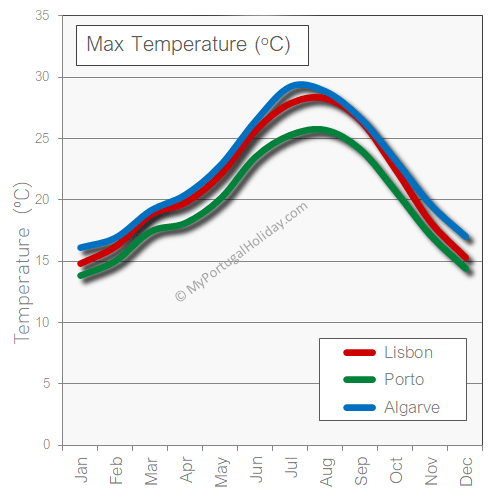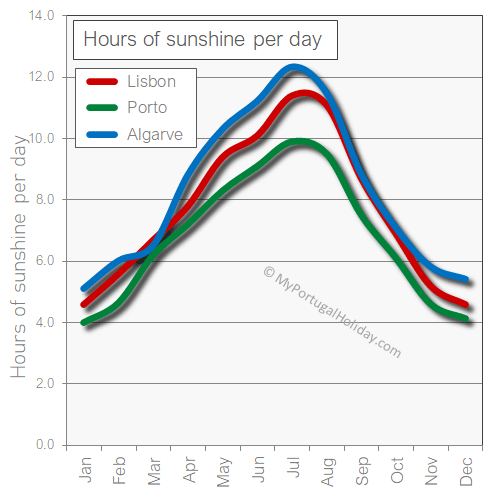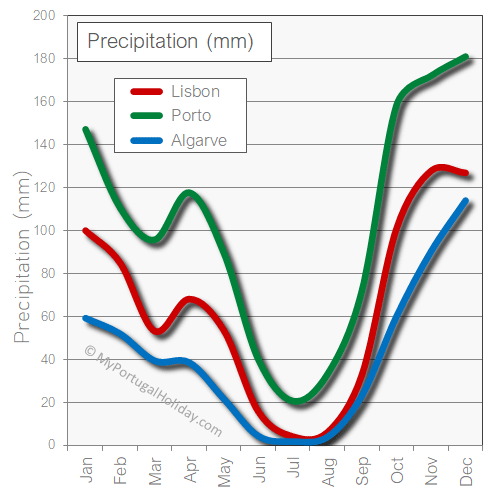MyPortugalHoliday.com
The best independent guide to Portugal
MyPortugalHoliday.com
The best independent guide to Portugal
When to visit Portugal: The best seasons and months for your holiday
Portugal's fantastic climate makes it an appealing destination almost year-round.
The country generally experiences hot, dry summers, warm and bright springs and autumns, and mild winters that can be very wet in the north. Southern regions tend to be hotter and drier, while northern areas like Porto and the Costa Verde coastline can be quite wet in winter.
Despite its relatively small size, Portugal can experience widely different weather conditions. This is especially between late autumn and early spring (October-April), when it can be hammering down with rain in Porto but gloriously sunny in Faro.
July and August mark the peak season, when beaches are busiest and cities are filled with tourists. While coastal areas are ideal for sun-seekers during these months, the interior can become uncomfortably hot for sightseeing.
For the best balance of pleasant weather and smaller crowds throughout the country, visit during the shoulder seasons of May-June or September. June is the month of festivals and is the best month to visit Portugal, especially Lisbon and Porto when the Santos Populares and the Festa de São João are held.
The Algarve in southern Portugal offers some of mainland Europe's mildest winter weather. While not warm enough for sunbathing, it's pleasant for exploring and outdoor activities.
Lisbon, the capital, is a year-round destination, though winter visitors should be prepared for the possibility of rain. Porto, however, is best visited between May and October, as winters can be wet and chilly.
Each season in Portugal offers its own unique charm and appeal, catering to different interests and activities. The following sections will guide you through what to expect in various regions throughout the year, suggest ideal destinations for each season, and help you plan your perfect Portuguese getaway.
Portugal's weather - when to visit?
Portugal's climate is significantly influenced by its latitude and proximity to the Atlantic Ocean, resulting in surprising regional variations despite the country's relatively small size.
It's challenging to make sweeping statements about Portugal's weather due to considerable seasonal and regional variations. To better understand the country's weather patterns, it's best to consider Portugal in four distinct zones:
• The Algarve and southwestern coastline
• Lisbon and the central western coastline
• The north, covering Porto, the Douro Valley and Coimbra
• The interior and east of Portugal, covering the Alentejo and Beira regions
The map below outlines these different regions: red represents the Algarve, green is Lisbon, blue indicates the north, and yellow shows the interior.
Note: Suggestions on where to visit in different seasons are provided later in the guide.
Algarve weather
The Algarve boasts Portugal's most favourable climate, with hot summers, mild winters, and pleasant conditions in spring and autumn. You can expect daytime highs of 28°C and over 12 hours of sunshine in August, while December remains comfortable at 16°C with 5 hours of daily sun. However, the region's excellent weather comes with drawbacks - namely the summer tourist crowds and inflated prices. For a more enjoyable and budget-friendly experience, consider visiting the Algarve either side of the peak summer season.
The interior weather
Portugal's interior experiences the country's driest climate, but summer brings intense heat with temperatures often soaring above 45°C, exacerbated by strong sun and a lack of cooling sea breezes. The best time to explore this region is from October to May, with March and April being particularly appealing. After the light winter rains, the landscape briefly comes alive with lush greenery and colourful wildflowers before the harsh summer sun takes hold.
Northern weather
Porto and northern Portugal offer a cooler alternative during the peak summer season, making them ideal destinations when other regions swelter. Porto and the north Portugal coastline are fantastic holiday destinations in August, offering exceptional value for money when compared to the inflated prices elsewhere in Europe.
However, the area sees surprisingly heavy rainfall from October to February, surpassing many northern European cities. In fact, Porto holds the distinction of being the wettest major city with a Mediterranean climate. Given these weather patterns, you'll find the best conditions for exploring Porto and the north between May and September.
Lisbon weather
Lisbon and the central western coastline enjoy a climate that strikes a balance between the cooler north and the scorching interior. Summers are warm but not as intense as inland areas, while winters are drier than in the north. For the best experience in the Lisbon region, plan your visit for May, June or September. July can be a good option if you don't mind slightly higher temperatures, while October is generally pleasant but carries a small risk of rain and overcast days.
When planning your trip to Portugal, keep these key points in mind:
• The north can be very wet from October through to April
• The Algarve is extremely busy with tourists during the summer school holidays (mid-July and August)
• The interior is too hot (average 35°C+/95°F+) for sightseeing during the summer
• Porto and the north coastline are hidden gems for August holidays, offering a perfect blend of good weather and value for money
The following weather charts display the average weather for the north (Porto), Lisbon and the Algarve (Faro).
June: The month of festivities
June stands out as the best time to visit Portugal, offering a perfect blend of fantastic weather, fewer tourists, and a wealth of festivals.
Lisbon comes alive with the Santos Populares celebrations between the first weekend and June 12th. These daily street parties, ostensibly honouring Saint Anthony's feast day on the 13th, are really an excuse to indulge in grilled sardines and have a great time.
The historic centre’s plazas transform into lively nightly gatherings, complete with traditional music, pop-up bars and BBQs selling grilled sardines. This vibrant atmosphere continues on weekends until the end of June.
In Porto, the equivalent festival occurs later in the month, building up to the feast day of Saint John on June 23rd.
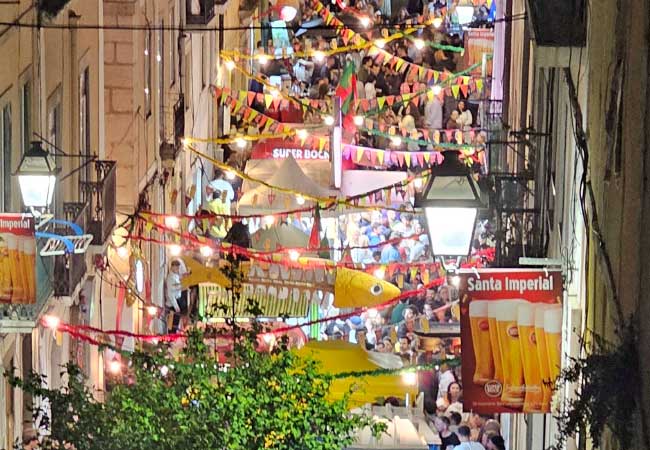
The Bica neighbourhood in Lisbon during the Santos Populares
Where to visit in Portugal in the summer?
The summer season is the busiest time of year in Portugal.
Summer in Portugal sees families flocking to the Algarve, tourists filling the cities, and locals escaping to beachside campsites and holiday homes. While everywhere tends to be busy with higher prices, there's an undeniable holiday buzz in resort towns.
The interior and eastern regions of Portugal become uncomfortably hot for sightseeing, with temperatures soaring under the intense summer sun. Your best bet is to stay close to the coast, preferably near a beach where you can cool off.
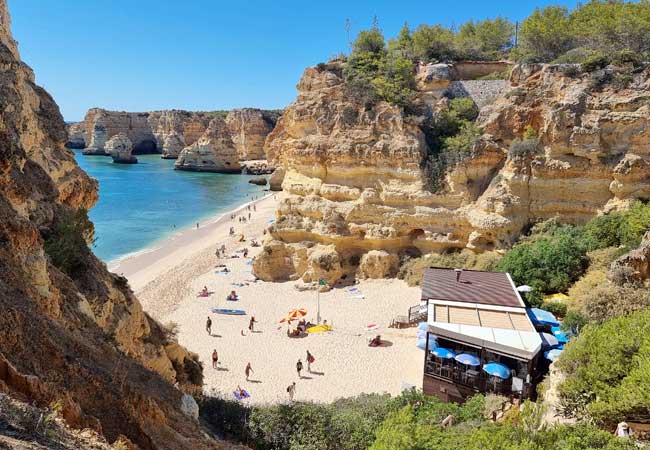
The stunning Praia da Marinha beach along the Algarve coastline
For a lively beach holiday, consider Albufeira, Vilamoura, Lagos and Praia da Rocha in the Algarve are always good choices. For a beach resort with a bit of Portuguese character, consider Tavira in the Algarve, Cascais or Sesimbra near Lisbon or Nazare, Ericeira or São Martinho do Porto on the Costa da Prata (Silver Coast).
The beautiful Alentejo coastline remains relatively undiscovered by foreign visitors. Vila Nova de Milfontes and Porto Covo are two charming beach towns worth exploring in this region.
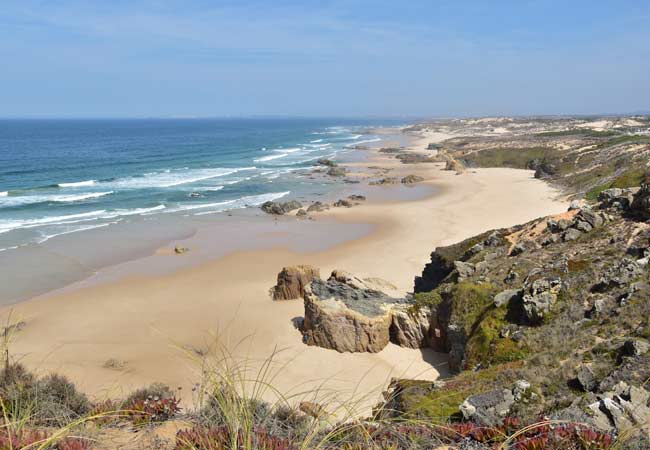
The wild and pristine Alentejo coastline near Vila Nova de Milfontes
If you are wishing a city break or more of a sightseeing holiday, then the north of Portugal is the area to visit during the summer.
Porto offers an outstanding mix of attractions, day trips, and beaches, with far fewer crowds than Lisbon in peak season. If you're planning a touring holiday and want to avoid tourist masses, head to Portugal's far northern coastline around Viana do Castelo.
Related articles: Porto guide
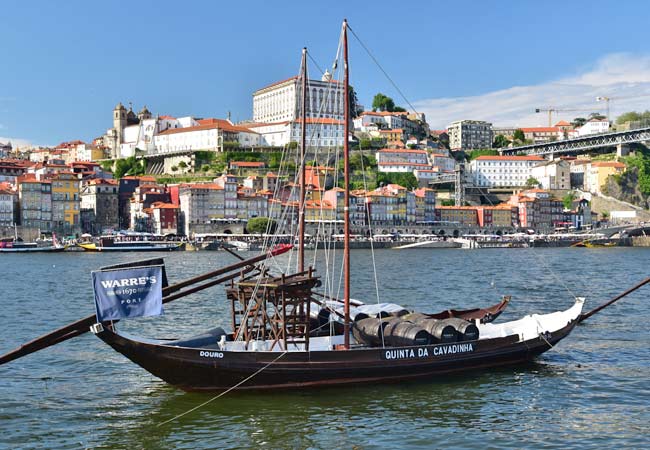
Porto is an exciting mix of history, culture, and world-renowned port wine cellars
Portugal in the spring
Late spring (May-June) is the best season to visit Portugal. The weather is glorious but without the extremes of summer, and the tourist areas are fully open but not overcrowded.
In the late spring, the whole of Portugal could be visited, but Lisbon Lisbon is at its finest. Lisbon is amazing during this period, especially in early June with the Popular Saint festivals (Festas dos Santos Populares). The city comes alive with colourful decorations and nightly traditional dances. The highlight is the carnival-like atmosphere on the eve of Saint Anthony's feast day (June 13th), when the entire city takes to the streets to celebrate.
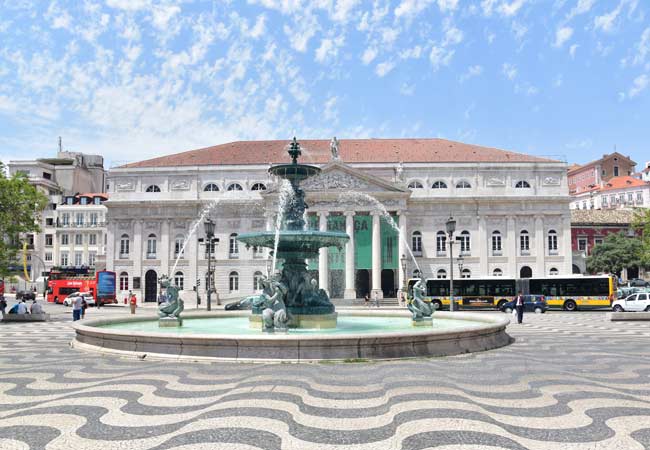
Lisbon is always an outstanding destination but is even better in June!
Spring is ideal for exploring the Algarve, whether you're after a relaxing beach holiday or a regional tour. This southern region warms up earlier than the rest of Portugal, often providing beach-worthy weather from Easter onwards. Easter also marks the reopening of many seasonal businesses after the winter lull.
April is a surprisingly wet month in northern Portugal, and there can be very intense downpours. We would suggest leaving any visit to Porto and the Douro Valley to May or later spring.
Related articles: Lisbon guide
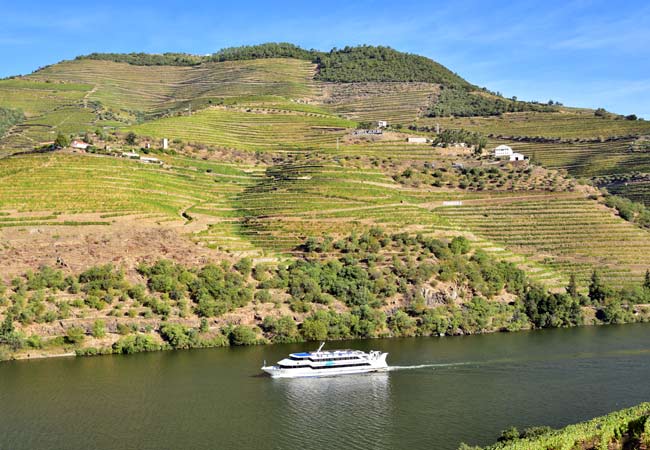
For a relaxing activity, a cruise along the Douro River can’t be beaten, but save it for May and onwards
Portugal in the winter
Winter in Portugal can be a mixed experience. You might be lucky with bright, mild days, or find yourself caught in a week-long downpour. The best approach for a winter holiday in Portugal is to have flexible plans that can adapt to the changing weather.
The Algarve offers the most reliable winter weather, with the driest and warmest conditions in mainland Portugal, though it's not entirely immune to rain. You won't find beach weather (temperatures max out around 18°C), but it's pleasant enough for activities like cycling, hiking, or touring.
If you're heading to the Algarve in winter, stick to larger resort towns like Albufeira, Lagos, or Praia da Rocha, where most tourist facilities and hotels remain open year-round.
Lisbon can be a good choice for a winter city break. The capital offers plenty of indoor attractions to keep you occupied if the weather turns poor. However, be prepared for the possibility of rain and cooler temperatures.
It's best to avoid Porto and northern Portugal during winter, as these regions can experience heavy and persistent rainfall.

Christmas is a great time to visit Lisbon
Portugal in Autumn
Autumn, like spring, is an excellent time to explore the whole of Portugal.
September remains one of the busiest months in the Algarve, as couples seeking sun and relaxation flock to the region after the hectic school holidays. The weather is still great, making it an ideal time to visit any part of the country. You might find good deals on Douro River cruises and last-minute trips to Porto during this period.
The milder temperatures of September and October create perfect conditions for exploring eastern Portugal. This is an ideal time to visit the historic city of Evora, the unique boulder town of Monsanto, or hike in the Serra da Estrela mountains.
By late October, the weather begins to cool, and it's worth considering Lisbon or the Algarve coastline for the remainder of autumn.
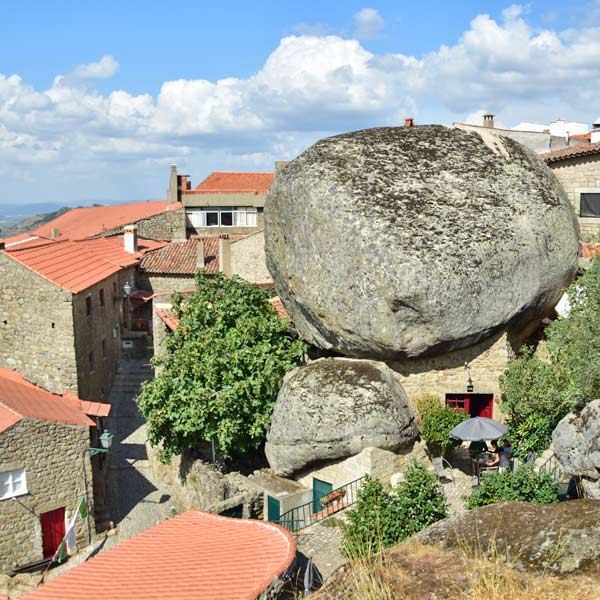
The village of Monsanto was constructed around the giant boulders on the top of the hill
The worst time of year to visit Portugal
If you're looking to experience Portugal at its best, you might want to avoid November and January. These months typically offer the least favourable conditions for tourists.
November and January bracket the Christmas season, missing out on both the festive atmosphere and the milder autumn or spring weather. During these months, Portugal faces its most challenging weather conditions. Lisbon sees average high temperatures of around 15°C (59°F) and lows of about 8°C (46°F), with increased chances of rainfall and overcast skies.
In the Algarve, many smaller towns essentially shut down for the low season. Even larger towns can feel eerily quiet, with numerous restaurants, bars, and attractions closed or operating on reduced hours. This can significantly limit your options for dining and entertainment.
Many outdoor tours and excursions may not operate during this period or may be subject to cancellation due to weather conditions.
If you do choose to travel to Portugal in these months, head to Lisbon or one of the larger towns of the Algarve such as Lagos or Albufeira.
Discover the best of Portugal with our guides
Expert Insight: These guides are curated by Philip Giddings, a travel writer with over 25 years of local experience in Portugal. Since 2008, Phil has focused on providing verified, on-the-ground advice for the whole of Portugal, supported by deep cultural ties through his Portuguese family. Read the full story here.
